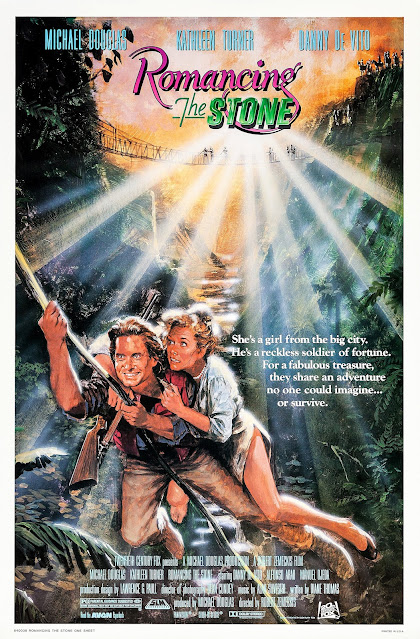Six months into their round the world cruise, the bloom is off Joan (Kathleen Turner) and Jack’s (Michael Douglas) romance.
When Joan is offered the chance to pen the biography of an Arab ruler, Omar Khalifa (Spiros Focás), she abandons Jack.
Jack soon finds himself following Joan, to both rescue his love, and find the titular Jewel of the Nile.
I feel like I watched this movie multiple times when I was a kid. I remember so many images from it - the pirate opening, the plane chase, the titular character Al-Julhara (Avner Eisenberg) walking through the flames at the end.
I probably filed it with the Indiana Jones movies as a comparable action adventure.
I do not think I knew it was a sequel for a long time. I certainly did not make the connection with Romancing the Stone.
After this last re-watch of Romancing I was jazzed to check out the sequel. I knew its reputation, but I thought I had its measure.
This movie was rushed into production following the surprise success of the original, and it feels it.
It is bigger in scope but without the strong characterisation of the original, it feels smaller.
Right from the beginning the movie is off.
Gone is Alan Silvestri’s score; in is Jack Nitzche with synthesisers.
The opening fantasy is set on a stylised set. There is no attempt to ape the genre as in the opening of the previous film.
In an early line, Joan’s publisher (Holland Taylor) admonishes her for being stuck on a happy ending, when real life does not tie up so neatly.
It is meant to set the table for the conflict between the couple - instead it punctures the movie.
The focus and the perspective is completely different - instead of following Joan, the film seems to be pitched toward Jack.
Joan is listless, dropping Jack to take up a stranger’s offer. It is meant to be motivated by her feeling stuck both personally and creatively but it does not come off that way.
More importantly what is attractive about Omar’s offer that would draw Joan - especially the Joan of the previous film - in?
Jack has lost all sense of vulnerability.
He is now a man’s man who is jealous of his partner.
He seems to have lost all the sensitivity and empathy he had developed toward Joan.
Whether it is the script or the strain of the chaotic production, Douglas seems irritated.
He also carries a level of sleaze that was not present in the original.
Douglas has always been a little seedy - it worked for Romancing the Stone - but he seems to be evolving toward the persona he would consolidate with Gordon Gecko and Fatal Attraction.
Danny DeVito is the real star of the movie.
The film is basically a buddy picture between Douglas and DeVito as they try to find Turner.
And when the central couple reunite, Ralph gets his own subplot: He ends the movie as a Sufi Muslim and member of a band of freedom fighters.
Taking over from Robert Zemeckis, Lewis Teague lacks the former’s comic touch. The film is vaguely competent, but the film never manages to find its feet as either an action adventure flick or a romantic comedy. Watching this movie, you realise how complicated the blend of genres and tones is in Romancing the Stone.
Part of that tonal difference also feels like a result of the score - instead of orchestral sweep, we get noodling with synthesisers. And when it is not composer Jack Nitzsche, the film is packed with contemporary pop songs, as though the film is more concerned with selling the soundtrack album.
The biggest missing piece is writer Diane Thomas. There is no uniting spark to Jewel of the Nile - not in terms of the characters, the tone or the perspective on the genre. Her touch is sadly missing.
A tired, expensive cash grab.
Related



